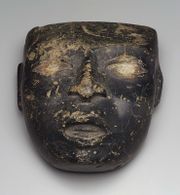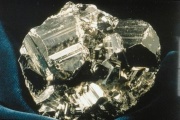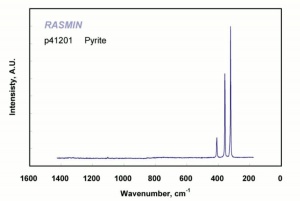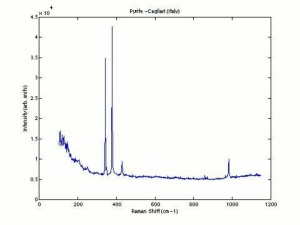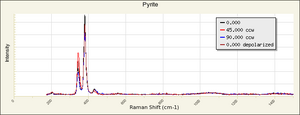Difference between revisions of "Iron disulfide"
Jump to navigation
Jump to search
(username removed) |
|||
| (7 intermediate revisions by 3 users not shown) | |||
| Line 1: | Line 1: | ||
| + | [[File:Iron pyrite inlays-SC36631.jpg|thumb|Iron pyrite inlays<br>MFA# 26.20]] | ||
[[File:pyriteemr1.jpg|thumb|Iron pyrite]] | [[File:pyriteemr1.jpg|thumb|Iron pyrite]] | ||
| − | + | Primarily occurs as a yellowish mineral with a metallic luster called [[pyrite]]. Iron disulfide also occurs as that mineral [[marcasite]]. Major sources for iron pyrite include sites in India, Turkey, and Russia. It was called fool's gold because its color and metallic sheen often is mistake for gold. Polished pieces of iron pyrite have been used for necklaces and bracelets. Ethanolamine thioglycollate treatments have been used to minimize the decomposition of pyritic specimens (Cornish 1984). | |
| − | + | See also [[pyrrhotite]]. | |
| − | |||
| − | |||
== Synonyms and Related Terms == | == Synonyms and Related Terms == | ||
| Line 10: | Line 9: | ||
iron (II) disulfide; iron pyrite; pyrite; fool's gold; martial pyrite; mundic; factitous pyrite; Pyrit (Deut.); pyrite (Fr.); pyriet (Ned.); piryt (Pol.); pirita (Port.); | iron (II) disulfide; iron pyrite; pyrite; fool's gold; martial pyrite; mundic; factitous pyrite; Pyrit (Deut.); pyrite (Fr.); pyriet (Ned.); piryt (Pol.); pirita (Port.); | ||
| − | [[[SliderGallery rightalign|pyriteRS.jpg~Raman|Pyriteitaly2.jpg~Raman]]] | + | [[[SliderGallery rightalign|pyriteRS.jpg~Raman (RASMIN)|Pyriteitaly2.jpg~Raman (U of Parma)|Pyrite Raman RRUFF R050190.png~Raman (RRUFF)]]] |
| + | == Risks == | ||
| − | == | + | * Can evolve low levels of sulfur dioxide. |
| + | * Degrades in high humidity environments. | ||
| + | * ThermoFisher: [https://www.fishersci.com/shop/msdsproxy?productName=AC233300010&productDescription=IRON(II)SULFIDE%2CC.P.%2C+FU+1KG&catNo=AC23330-0010&vendorId=VN00032119&storeId=10652 SDS] | ||
| + | == Physical and Chemical Properties == | ||
| − | Insoluble in water | + | * Insoluble in water |
| + | * Magnetic after heating | ||
| + | * Crystal system = isometric | ||
| + | * Cleavage = poor | ||
| + | * Fracture = uneven | ||
| + | * Luster = metallic | ||
| + | * Streak = greenish black to brown | ||
{| class="wikitable" | {| class="wikitable" | ||
| Line 28: | Line 37: | ||
|- | |- | ||
! scope="row"| Melting Point | ! scope="row"| Melting Point | ||
| − | | 1171-1188 | + | | 1171-1188 C |
|- | |- | ||
! scope="row"| Density | ! scope="row"| Density | ||
| − | | 4.9-5.1 | + | | 4.9-5.1 g/ml |
|- | |- | ||
! scope="row"| Molecular Weight | ! scope="row"| Molecular Weight | ||
| Line 37: | Line 46: | ||
|} | |} | ||
| − | = | + | =Resources and Citations== |
| − | + | * L. Cornish, A.M. Doyle. "Use of Ethanolamine Thioglycollate in the Conservation of Pyritised Fossils" Palaeontology 27(2), 1984, 421-424. | |
| − | + | * Gem Identification Lab Manual, Gemological Institute of America, 2016. | |
| − | + | * WebMinerals: [http://webmineral.com/data/Pyrite.shtml Pyrite] | |
| − | |||
| − | |||
| − | |||
| − | |||
| − | |||
| − | |||
| − | |||
| − | |||
* C.W.Chesterman, K.E.Lowe, ''Audubon Society Field Guide to North American Rocks and Minerals'', Alfred A. Knopf, New York, 1979 | * C.W.Chesterman, K.E.Lowe, ''Audubon Society Field Guide to North American Rocks and Minerals'', Alfred A. Knopf, New York, 1979 | ||
| − | |||
* ''CRC Handbook of Chemistry and Physics'', Robert Weast (ed.), CRC Press, Boca Raton, Florida, v. 61, 1980 Comment: density=4.95-5.1 | * ''CRC Handbook of Chemistry and Physics'', Robert Weast (ed.), CRC Press, Boca Raton, Florida, v. 61, 1980 Comment: density=4.95-5.1 | ||
| − | |||
* Jack Odgen, ''Jewellery of the Ancient World'', Rizzoli International Publications Inc., New York City, 1982 | * Jack Odgen, ''Jewellery of the Ancient World'', Rizzoli International Publications Inc., New York City, 1982 | ||
| − | + | * Jon Byler, Submitted information, Jan. 23, 2006. melting point = 1171 C (Lange's Handbook 1985), melting point=1188C (CRC 78th ed.) | |
| − | * | + | * Wikipedia: [https://en.wikipedia.org/wiki/Pyrite Pyrite] (Accessed Sept. 14, 2005 andDec 2022) |
| − | |||
| − | * Wikipedia | ||
| − | |||
* G.S.Brady, ''Materials Handbook'', McGraw-Hill Book Co., New York, 1971 Comment: p. 422 | * G.S.Brady, ''Materials Handbook'', McGraw-Hill Book Co., New York, 1971 Comment: p. 422 | ||
| − | |||
* Susan E. Schur, Conservation Terminology: A review of Past & Current Nomenclature of Materials, ''Technology and Conservation'', Spring (p.34-39); Summer (p.35-38); Fall (p.25-36), 1985 | * Susan E. Schur, Conservation Terminology: A review of Past & Current Nomenclature of Materials, ''Technology and Conservation'', Spring (p.34-39); Summer (p.35-38); Fall (p.25-36), 1985 | ||
Latest revision as of 12:18, 28 December 2022
Primarily occurs as a yellowish mineral with a metallic luster called Pyrite. Iron disulfide also occurs as that mineral Marcasite. Major sources for iron pyrite include sites in India, Turkey, and Russia. It was called fool's gold because its color and metallic sheen often is mistake for gold. Polished pieces of iron pyrite have been used for necklaces and bracelets. Ethanolamine thioglycollate treatments have been used to minimize the decomposition of pyritic specimens (Cornish 1984).
See also Pyrrhotite.
Synonyms and Related Terms
iron (II) disulfide; iron pyrite; pyrite; fool's gold; martial pyrite; mundic; factitous pyrite; Pyrit (Deut.); pyrite (Fr.); pyriet (Ned.); piryt (Pol.); pirita (Port.);
Risks
- Can evolve low levels of sulfur dioxide.
- Degrades in high humidity environments.
- ThermoFisher: SDS
Physical and Chemical Properties
- Insoluble in water
- Magnetic after heating
- Crystal system = isometric
- Cleavage = poor
- Fracture = uneven
- Luster = metallic
- Streak = greenish black to brown
| Composition | FeS2 |
|---|---|
| CAS | 1309-36-0 |
| Mohs Hardness | 6.0 - 6.5 |
| Melting Point | 1171-1188 C |
| Density | 4.9-5.1 g/ml |
| Molecular Weight | mol. wt. = 119.967 |
Resources and Citations=
- L. Cornish, A.M. Doyle. "Use of Ethanolamine Thioglycollate in the Conservation of Pyritised Fossils" Palaeontology 27(2), 1984, 421-424.
- Gem Identification Lab Manual, Gemological Institute of America, 2016.
- WebMinerals: Pyrite
- C.W.Chesterman, K.E.Lowe, Audubon Society Field Guide to North American Rocks and Minerals, Alfred A. Knopf, New York, 1979
- CRC Handbook of Chemistry and Physics, Robert Weast (ed.), CRC Press, Boca Raton, Florida, v. 61, 1980 Comment: density=4.95-5.1
- Jack Odgen, Jewellery of the Ancient World, Rizzoli International Publications Inc., New York City, 1982
- Jon Byler, Submitted information, Jan. 23, 2006. melting point = 1171 C (Lange's Handbook 1985), melting point=1188C (CRC 78th ed.)
- Wikipedia: Pyrite (Accessed Sept. 14, 2005 andDec 2022)
- G.S.Brady, Materials Handbook, McGraw-Hill Book Co., New York, 1971 Comment: p. 422
- Susan E. Schur, Conservation Terminology: A review of Past & Current Nomenclature of Materials, Technology and Conservation, Spring (p.34-39); Summer (p.35-38); Fall (p.25-36), 1985
